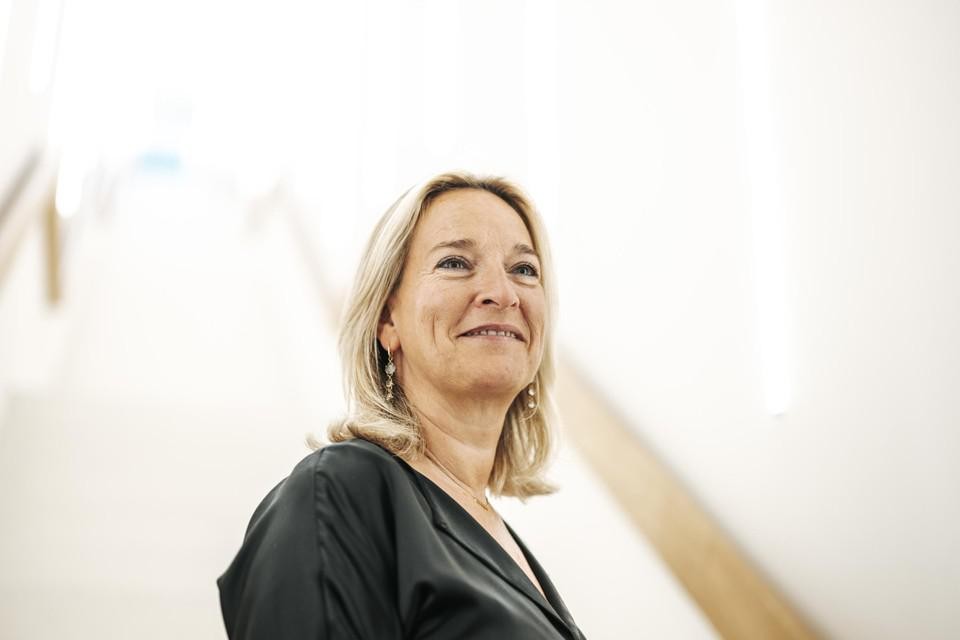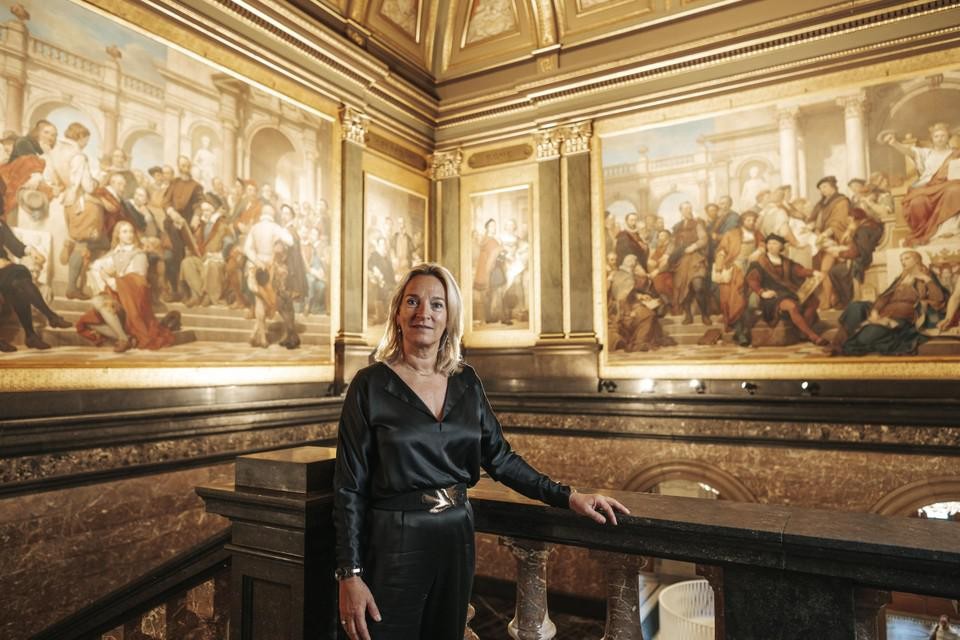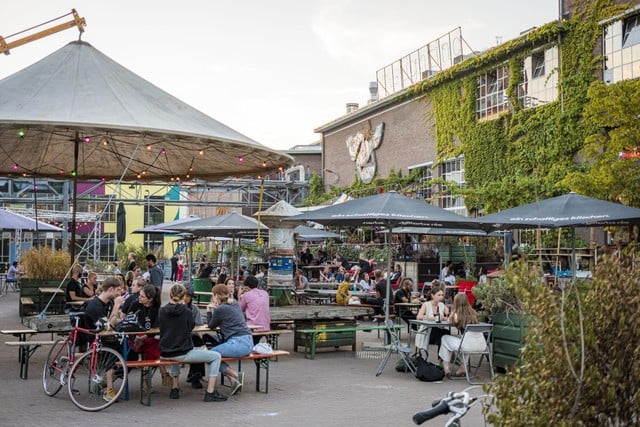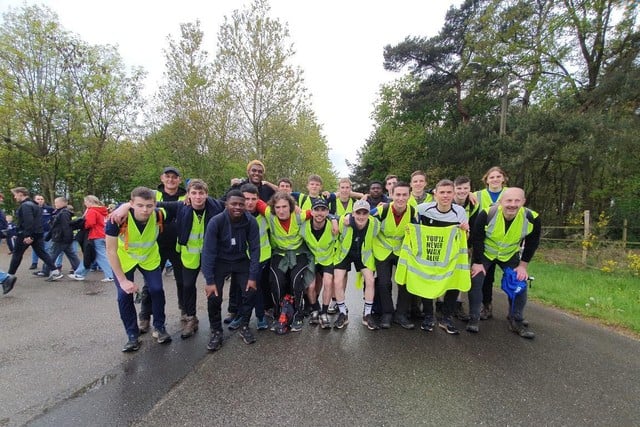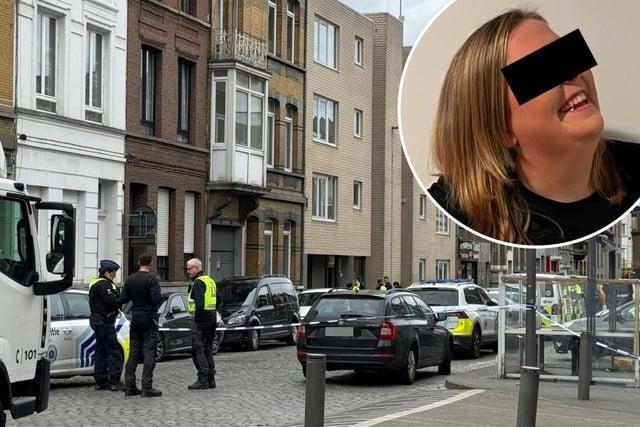Carmen Willems — © Photo Boumediene Belbachir
Carmen Willems (KMSKA): “We don’t know how those big works of Rubens got in here”
Managing Director Carmen Willems of Tongeren has been allowed to show “her” works by Rubens and Ensor to the world again. The Museum of Fine Arts in Antwerp is opening its doors with a big celebration, after an 11-year, over 100-million-euro restoration.
Willems leads us at high speed through the halls of KMSKA. “Walking all the way through the museum is 2.4 kilometres, so besides an aesthetic experience, it is also a physical effort,” she warns. Screws are still being screwed, spotlights hung and information plates installed.
Those who remember the stately, somewhat musty museum before its closure will certainly be surprised by its new section. The architects created two worlds in one building.
Along the outside, you can still see the historic building. In the old interior patios, bright white spaces have been created, with plenty of natural light. It brings out the brilliance of modern masters like Rik Wouters and James Ensor; a hidden corridor is suddenly a work of art in itself, with an explosion of colour.
“Highly instagramable,” Willems laughs. Classical art lovers, however, need not worry. The works of Jordaens and Van Dyck are still on display among the red plush and gold slats. We stop at ‘Seated Nude’ by Modigliani, one of the last works to have returned home from loan. “During the shutdown, we sent our collection on frequent trips,” Willems says. “It would have been crazy to keep the collection in our own warehouse all these years. Our Modigliani was the poster girl of the retrospective in Vienna.
We reached 11 million visitors with the loaned pieces. That says a lot about the international quality of our collection.” Noblesse oblige: the breakfast table is set under the ‘Adoration by the Magi’. “The first ever breakfast in the Rubens Room,” Willems laughs. “This work nevertheless remains our absolute masterpiece. It is extremely well documented, by the way. We are a hundred percent certain that Rubens painted it himself. In a fortnight. This painting is also our campaign image. This seems obvious, but since we have been unable to put our museum on the map all these years, we have disappeared from the collective memory. Younger people in particular don’t know us anymore. And Rubens remains the reason why this museum was founded in 1890. People had no place for his large altarpieces at the time. So we are staying true to our history.”
How many works will visitors end up seeing?
“We own over 8,000 pieces in total. Of these, we are currently displaying 640. We also know that people do not look at all the works with equal attention. Therefore, there are a number of information routes in the museum. There are hall texts for the general public, additional labels that go into more depth, audio guides or the app allow you to follow a highlights tour or find in-depth information about our hundred key works. In some rooms, the overall collection is more important; in others, it’s really all about the masterpiece.
For example, you can look at Fouquet’s famous Madonna with two modern masters behind you: a Marlene Dumas and a Luc Tuymans. In consultation with Tuymans, we deliberately chose ‘Der diagnostische Blick IV’. The piercing gaze looks indifferently past the gorgeous Madonna. She is not used to that.”
The Madonna by Fouquet — © BELGAIMAGE
In any case, there is an increasing focus in museums on experience, perhaps even more so that purely looking at art?
“A challenge, especially for larger museums, is museum fatigue, a form of boredom that strikes after wandering the corridors for a while. So we have been thinking carefully about how to counter that. For example, we developed multimedia screens together with production house De Chinezen, known for Arnout Hauben and Homo Universalis, among others. Curators and artists talk about their connection to the work, but if a painting shows a brothel, for example, the focus can also be on a sex worker talking about what she sees.”
One notable initiative is the Radio Bart studio, manned by a blind employee.
“Bart is one of our employees. Having gone blind, he now welcomes visitors as a full-fledged guide. With his mobile studio, he sits by a work and invites people to describe what they see. This allows participants to start looking at a painting very differently. Bart is also trained to respond to visitors’ emotions. We are now crowdfunding to train more blind people as guides. This can provide employment, but other European museums are also looking into it with great interest. Everyone is also struck by the fact that Bart himself appears to be reborn. This project is an excellent example of our new DNA. We literally and figuratively shook off the old dust.”
If you walk into a classical museum in Europe, the audience is still predominantly white. How do you bring in new groups in a multicultural city like Antwerp?
“That’s true. When I started here in 2017, I found myself in a team lacking in diversity. We have now really made it a point to convey the message in our recruitment that we are open to people of all backgrounds. You can see that diversity in our team now, but seeing it in the public will be a challenge. It is also important to acknowledge that. We are never going to succeed in making our audience a perfect reflection of Antwerp’s population, but we have to at least make every effort. For example, we have 22 ‘artists in residence’ with us. The first shortlist was too white as well. They are deliberately not visual artists, but rather people from all other disciplines who have been inspired by our collection. Playwrights Dimitri Leue and Jaoud Alloul, music group Het Zesde Metaal, dancer Geoffrey Anane, etc. Actor Tom Van Dyck created his own audio guide. Instruments depicted in a Memling painting were physically recreated and the Oltramontano company played a piece on them.”
“Fine arts museums sometimes simply sit back with an attitude of ‘the public will come anyway’. But through clever storytelling and especially adding experience, we hope to attract a wider audience. That is also the mandate we have been given by the Government of Flanders.”
Carmen Willems, managing director KMSKA
You do have to overcome a threshold to enter the mighty building for the first time.
“Absolutely. That is why we created a new entrance at street level. It is literally an invitation to enter, and highly symbolic.”
So are the non-exhibited works now also here in the renovated warehouse?
“During the shutdown, we commissioned an external warehouse and restoration studio in Kallo. We also used that time to carry out 180 restorations, partly with private funds. So the collection is in tip-top condition. This was needed because not only was the building in need of repair, but some of the works were really in need of attention too. We will now restore the very large works in the hall, such as the large altarpieces by Rubens. Those cannot leave the hall. In fact, we don’t even know exactly how they got in here. Through the roof? Removed from their frames?”
So a Van Dyck already travelled from Kallo to the city centre by night?
“Indeed, but we didn’t publicise that too much.” (laughs)
Are there no plans to open up the warehouse, as happened in Rotterdam with the Boijmans Van Beuningen museum?
“An open warehouse was not a requirement when the Government of Flanders issued a master plan for this site. Of course, the building is also enclosed in the city centre. By the way, Boijmans Van Beuningen is also currently closed for renovation and has now loaned us some masterpieces, including a spectacular Dali.”
You have the largest collection of Ensors in the world. Don’t you get calls every day to borrow them?
“It is indeed the collection most in demand by far. They also travelled a lot during the shutdown, but now they are back and staying here (laughs). Incidentally, we will be holding a major Ensor exhibition in 2024, to mark 75 years of his death. My dream is also for us to show the ‘Entry of Christ into Brussels’, which is currently on display at the Getty museum in Los Angeles.”
With the insane prices these days in the art market, don’t you often get asked to sell works?
“Not very often, the market knows that our masterpieces are not for sale. We are, of course, constantly looking for additional resources to meet our budget. So people sometimes ask why we don’t sell anything then. Because you have to be honest: we have some works in our warehouse that are never going to make it out of there. But if you start selling your own collection, you are no longer a museum.”
There is also a painting on display here that was first attributed to Rubens, but was later agreed to be a Van Dyck. Does that affect a work’s value?
“Not really. A Van Dyck is not necessarily worth less than a Rubens. Those works are actually priceless. Nor are they insured for their full value. We insure only restorable damage. Our collection has travelled a lot over the past decade and we had virtually no claims to make. We have been able to fix all minor damage with our own restoration team.”
As general manager, to what extent are you involved in the collection?
“I am an economist by training, but of course I was director of the Gallo-Roman Museum in Tongeren for over 20 years. When I arrived here, the choice of the split between the old and modern masters had already been made and a list of works was ready. We then started thinking about what stories we would tell the various different audiences we identified. That is a huge job. To that end, we collaborated across all teams. In Tongeren, we had a collection of everyday utensils. We did not have the beautiful sculptures from Rome. Many steps were needed to make the collection sexy. You start here with a top collection. Fine arts museums sometimes simply sit back with an attitude of ‘the public will come anyway’. But through clever storytelling and especially adding experience, we hope to attract a wider audience. That is also the mandate we have been given by the Government of Flanders.”
Is this a dream job for someone who once did her thesis on arts sponsorship?
“As a child, I played the piano well and I wanted to study musicology. But my father, who was a school headmaster as an agricultural engineer, thought that was a luxurious study. So I studied economics, but I always looked for the interface with art and wanted to end up in the cultural sector. I became director of the Gallo-Roman Museum at a young age, but when I stepped out of the sector for a while after 21 years, I did miss the museum world. So yes, working in a museum is the most wonderful job in the world for me. In politics, I thought being mayor was the best job, and I was able to do it. So a lot comes together here: world-class art, education, communication as well as hard numbers. I was brought here in 2017 because I had experience in building a museum. At the time, the project was in a slump. It took too long, and more money was needed. I used to work at Interbuild, so I also had some experience in the construction world. The funny thing is that my then boss now has his office near here. He is one of our sponsors now.”
© Photo Boumediene Belbachir
Speaking of economics, how do you get the budget round?
“The Government of Flanders made an investment of 100 million euros. Kudos for that. The master plan has been fully implemented, even though at the beginning there was a lot of doubt about whether it would work. But now both the building, facades, offices and garden have been tackled. Over 100 million euros for 21,000 m² is actually cheap, if you compare it with the restoration of the Rijksmuseum in Amsterdam, for example. The works certainly could have been better coordinated, but in the meantime, the travelling collection did not hurt us either. As for the operating budget, we are in a more difficult trajectory. When the museum closed, this was €6.5 million a year. Now we are still negotiating with the government for a final budget. We are now operating with an annual allocation of around €8.5 million. With staff costs and exploding heating costs, that is a difficult situation, so we are looking to supplement that budget ourselves. Fortunately, cooperation with sponsors and partners is going much better than expected. There are also concessions for catering, the museum shop and ticket sales. A ticket costs 20 euros. Entrance is free with the museum pass. We can receive more than 5,000 visitors a day and we are ambitious: we are aiming for 150,000 visitors this year. And 250,000 a year from then on. But to close our budget, we could do with more.”
Are you not afraid that the economic crisis will affect visitor numbers?
“In difficult times, a museum can also be a place to unwind and find solace from difficult situations. We really want to focus on that emotional level. Our baseline is ‘the most beautiful feeling’. For ‘Everyone Famous’, one of our volunteers testified about her burnout. She was struck by Rik Wouters’ work ‘The Ironer’. She saw in it the simplicity of an act and after weeks of hanging out on the sofa, ironing was the first thing she was able to do again. Artworks really do have that power. I myself have also experienced enormously over the past few weeks how much art can touch people. I lost my brother in early August. He visited the museum a few days before he passed away. I had invited him to Antwerp for a few days. Joël was not really into art, but he walked around here for a few hours. At the end, he said one piece had really stayed with him. He laughingly described a ‘Maria figure with fake breasts’. He was very proud when I said he had picked out our top piece, the Madonna by Fouquet. I am lucky to be able to walk past it every day now and it gives me comfort, even though I am not religious at all.”
Did you sleep well the last few days before the opening?
“I am not a very good sleeper in general anyway, but these days I am particularly tired. Working days of 12 to 14 hours are no exception. But the passion of the whole team generates a lot of energy. Our offices are currently being remodelled, we are up to our ears in dust, and yet no one is complaining about that.”


